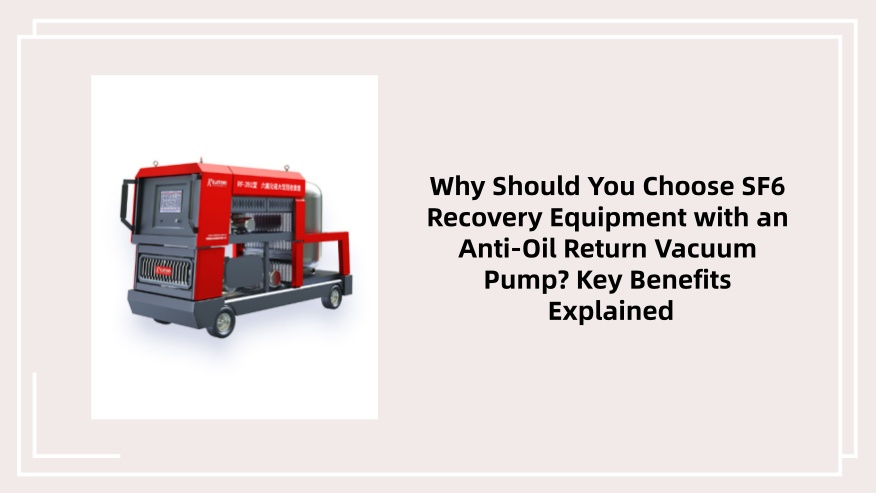
- SF6 Relations
- 2025-09-25
SF6 (sulfur hexafluoride) gas is widely used in high-voltage electrical equipment—such as GIS (gas-insulated switchgear), transformers, and circuit breakers—due to its excellent insulation and arc-quenching properties. However, SF6 is a potent greenhouse gas with a global warming potential (GWP) 23,500 times that of CO₂, making its proper recovery, recycling, and reuse critical for environmental compliance and operational cost savings. This is where SF6 recovery equipment with an anti-oil return vacuum pump stands out: it addresses a key pain point of traditional systems while boosting performance.
Why Anti-Oil Return Vacuum Pumps Matter for SF6 Recovery
Traditional SF6 recovery equipment often uses standard vacuum pumps that risk “oil return”—a phenomenon where pump oil flows back into the SF6 gas circuit. This contamination has severe consequences: it degrades the insulation quality of SF6, damages sensitive electrical components, and requires costly reprocessing to remove oil impurities. In contrast, an anti-oil return vacuum pump integrates specialized design features (e.g., one-way check valves, oil separation chambers, and pressure-sensitive seals) to prevent oil from entering the gas stream.
For operators, this means two critical benefits: higher SF6 purity post-recovery (meeting IEC 60480 standards for reuse) and reduced maintenance costs. By eliminating oil contamination, the equipment extends the lifespan of both the recovery system and the electrical assets it services, minimizing unplanned downtime.
How SF6 Recovery Equipment with Anti-Oil Return Pumps Works
The system operates in four core stages, with the anti-oil return vacuum pump serving as a backbone:
- Evacuation: The anti-oil return vacuum pump first creates a deep vacuum in the target electrical equipment (e.g., a GIS tank) and the recovery system’s hoses. Its anti-oil design ensures no oil is drawn into the empty equipment during this step.
- SF6 Extraction: Once the vacuum is established, the pump pulls SF6 gas from the electrical asset into the recovery unit’s compression chamber. The anti-oil mechanism remains active here, blocking oil from mixing with the extracted gas.
- Purification: The gas then passes through filters to remove moisture, particulates, and any residual impurities. Since oil contamination is already prevented, the purification process is more efficient and requires less frequent filter replacement.
- Storage or Reuse: The clean SF6 is either compressed into high-pressure cylinders for storage or directly recycled back into the electrical equipment—all without the risk of oil-related damage.
Key performance metrics of these systems include a ultimate vacuum degree of ≤1 mbar (critical for thorough SF6 extraction) and a recovery rate of over 99%, ensuring minimal gas loss to the atmosphere.
Applications Across Industries
SF6 recovery equipment with anti-oil return vacuum pumps is indispensable in sectors where high-voltage electrical systems are central:
- Power Utilities: For maintaining substations and transmission grids, where GIS and transformers rely on pure SF6 to avoid breakdowns.
- Renewable Energy: Wind and solar farms use SF6 in their grid-connection equipment; this recovery system ensures compliance with green energy regulations.
- Railway & Metro: Traction substations for electric railways depend on SF6 switchgear—portable versions of this recovery equipment are ideal for on-site maintenance.
- Industrial Manufacturing: Heavy industries (e.g., steel, mining) use large electrical motors with SF6 insulation; the anti-oil feature protects these expensive assets from premature failure.
Key Considerations When Choosing the Equipment
To maximize value and compliance, prioritize these factors:
- Anti-Oil Return Reliability: Verify the pump’s design (e.g., dual one-way valves) and check manufacturer certifications (e.g., ISO 9001, CE) for oil contamination control.
- Recovery Efficiency: Look for systems with a high pumping speed (e.g., ≥50 m³/h) and low residual gas pressure, as this reduces recovery time.
- Portability vs. Stationary Use: On-site maintenance requires compact, wheeled units, while centralized facilities may benefit from stationary systems with larger storage capacities.
- Smart Monitoring: Opt for equipment with digital displays to track vacuum levels, SF6 purity, and pump oil status—this enables proactive maintenance.
- Environmental Compliance: Ensure the system meets global standards (e.g., EPA’s SF6 emission rules, EU’s F-Gas Regulation) to avoid penalties.
SF6 recovery equipment with an anti-oil return vacuum pump is a game-changer for industries relying on SF6-insulated electrical systems. By eliminating oil contamination, it enhances operational reliability, reduces environmental impact, and cuts long-term costs. As regulations on SF6 emissions grow stricter, investing in this technology is not just a compliance measure—it’s a strategic choice to protect assets and support sustainability. For businesses seeking to optimize their SF6 management, prioritizing systems with proven anti-oil return pumps will ensure long-term efficiency and peace of mind.
Leave a Reply